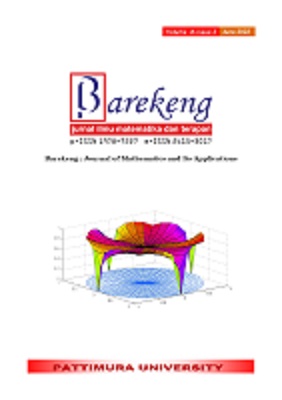DETERMINATION OF THE RESTRAINED DOMINATION NUMBER ON VERTEX AMALGAMATION AND EDGE AMALGAMATION OF THE PATH GRAPH WITH THE SAME ORDER
Abstract
Graph theory is a mathematics section that studies discrete objects. One of the concepts studied in graph theory is the restrained dominating set which aims to find the restrained dominating number. This research was conducted by examining the graph operation result of the vertex and edges amalgamation of the path graph in the same order. The method used in this research is the deductive method by using existing theorems to produce new theorems that will be proven deductively true. This research aimed to determine the restrained dominating number in vertex and edges amalgamation of the path graph in the same order. The results obtained from this study are in the form of the theorem about the restrained dominating number of vertex and edges amalgamation of the path graph in the same order, namely: for , ⌋, and for , ⌋.
Downloads
References
R. Munir, Matematika Diskrit, Ketiga [Discrete Mathematics, Third]. Bandung: Informatika Bandung, 2012.
R. Adawiyah, “Penentuan Bilangan Dominasi Sisi Pada Graf Hasil Operasi Produk Tensor,” ["Determining the Domination of the Edge Number in the Graph of the Operating Result of the Tensor Product,"] Progr. Magister, Jur. Mat. Fak. Mat. dan Ilmu Pengetah. Alam, Inst. Teknol. Sepuluh Nop. Surabaya, 2016.
L. Maro, “Himpunan Dominasi Terkendali pada Korona Graf Lintasan dengan Graf Lintasan, Graf Siklus dengan Graf Siklus, dan Graf Lengkap dengan Graf Lengkap,” ["Restrained dominating set in Coronary of Path Graph with Path Graph, Cycle Graph with Cycle Graph, and Complete Graph with Complete Graph,"] Progr. Stud. Magister Mat. Fak. Mat. dan Ilmu Pengetah. Alam, Sekol. Pascasarjana, Univ. Hasanuddin Makassar, 2017.
G. S. Domke, J. H. Hattingh, S. T. Hedetniemi, R. C. Laskar, and L. R. Markus, “Restrained domination in graphs,” Discrete Math., vol. 203, pp. 61–69, 1999, [Online]. Available: www.elsevier.com/locate/disc.
H. D. Saputro, “Dominating Set pada Hasil Operasi Graf Khusus dan Aplikasinya,” ["Dominating Sets on the Results of Special Graph Operations and Their Applications,"] Jur. Mat. Fak. Mat. dan Ilmu Pengetah. Alam, Univ. Jember, 2015.
E. L. Enriquez, “Secure Restrained Domination in the Join and Corona of Graphs,” 2016. [Online]. Available: http://www.ripublication.com/gjpam.htm.
R. C. Alota and E. L. Enriquez, “On Disjoint Restrained Domination in Graphs 1,” 2016. [Online]. Available: http://www.ripublication.com/gjpam.htm.
D. K. Thakkar and & D. D. Pandya, “CRITICAL GRAPHS IN RESTRAINED DOMINATION.”
J. H. Hattingh and E. J. Joubert, “Restrained domination in claw-free graphs with minimum degree at least two,” Graphs Comb., vol. 25, no. 5, pp. 693–706, Feb. 2010, doi: 10.1007/s00373-010-0883-3.
J. H. Hattingh and E. J. Joubert, “Restrained domination in cubic graphs,” J. Comb. Optim., vol. 22, no. 2, pp. 166–179, Aug. 2011, doi: 10.1007/s10878-009-9281-2.
V. R. Kulli, “Inverse and Disjoint Restrained Domination in Graphs,” 2016. [Online]. Available: www.researchmathsci.org.
X. Chen, Vy. Jiaiig, D. Xiec, and Y. Wang, “Total restrained domination in unicyclic graphs,” Ars Comb., vol. 148, pp. 149–165, Jan. 2020.
S. R. Canoy, “Restrained domination in graphs under some binary operations,” Appl. Math. Sci., vol. 8, no. 121–124, pp. 6025–6031, 2014, doi: 10.12988/ams.2014.48597.
R. Ardiyansah and Darmaji, “Bilangan Kromatik Graf Hasil Amalgamasi Dua Buah Graf,” J. Sains dan Seni POMITS, vol. 02, no. 01, pp. 1–5, 2013.
R. Diestel, Graph Theory, Electronic. New York: Springer - Verlag Heidelberg, 2005.
J. H. Hattingh et al., “RESTRAINED DOMINATION IN UNICYCLIC GRAPHS,” 2009.
Authors who publish with this Journal agree to the following terms:
- Author retain copyright and grant the journal right of first publication with the work simultaneously licensed under a creative commons attribution license that allow others to share the work within an acknowledgement of the work’s authorship and initial publication of this journal.
- Authors are able to enter into separate, additional contractual arrangement for the non-exclusive distribution of the journal’s published version of the work (e.g. acknowledgement of its initial publication in this journal).
- Authors are permitted and encouraged to post their work online (e.g. in institutional repositories or on their websites) prior to and during the submission process, as it can lead to productive exchanges, as well as earlier and greater citation of published works.






1.gif)



